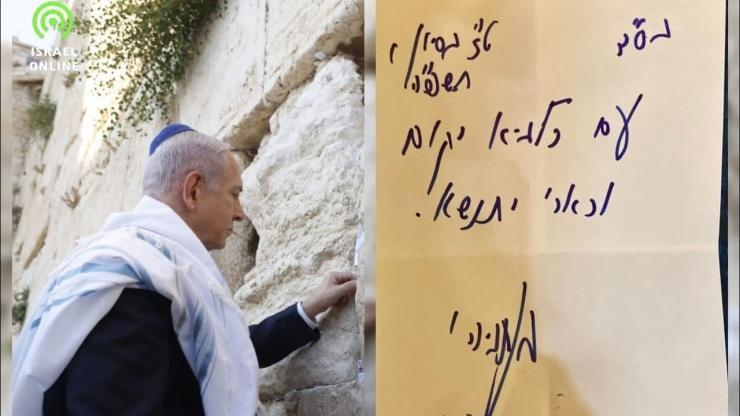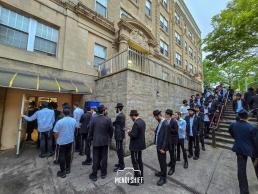Light the ‘Fire’ of Redemption Today
From the desk of Rabbi Nissim Lagziel, mashpia in Oholei Torah: We all know that the revelation of the teachings of Chassidus symbolize the beginning of the development of the Geula. The revelation of the Baal Shem Tov a few years prior to the year 5500 along with the birth of the Alter Rebbe about five years later, are certainly an inseparable part of the global process that needs to happen as part of the coming of the Geula. But why does it take so long? Why isn’t the time of the Geula known? • Click to Read
BEGIN WITH A GRIN
When G-d created the mule, He said to it, “You will be a mule. You will work from sunrise to sunset and carry heavy loads on your back. You will eat grass and will lack intelligence for 50 years.”
Said the mule, “A life like that?! Please give me only 20 years.” G-d agreed.
Along came the dog.
“You will guard the house and eat leftovers and bones for 25 years.”
Said the dog, “A life like that?! Please, 10 years are enough.” G-d agreed.
Then came the monkey.
“You will swing from tree to tree like a fool and make a laughingstock our of yourself for 20 years.”
The monkey said, “Living like a clown for 20 years is too much. Don’t give me more than 10 years.” And so it was.
Finally, along came man.
“You will rule all the animals and the entire world for 20 years.”
Man was offended. “Just 20 years?! Can’t I have more? Don’t you have any more?”
G-d agreed and since then man lives: 20 years like a human being. Then he marries and he lives 20 years like a mule. Another 15 years like a dog and finally, 10 years like a monkey.
“ON FIRE” UNTIL “MORNING”
Parshas Tzav begins with the laws of the Korban Tamid. The Torah teaches us that the portions that are to be burned on the altar can be brought at night too, all night. As long as the korban was slaughtered at the right time and the blood sprinkled on the altar before sunset, then after that it is fine to bring up on the altar the limbs and innards designated to burned on the altar throughout the night, as the Torah says (6:2), “All night, until the morning.”
For the past 300 years, this simple law generated an interesting and inspiring discussion on the topic of the coming of Moshiach and the future Geula. This is thanks to the fascinating commentary of the holy Ohr Ha’Chaim on the first five verses of the parsha.
“By way of allusion, the entire parsha hints to the final exile that we are in, to console us over the sadness of our souls.” With this sentence, the Ohr Ha’Chaim opens a new window into a deeper, more redemptive understanding of the beginning of parshas Tzav.
“Zos – This is the law of the Olah (burnt-offering)” – olah from the root aliya, and there is no aliya like the one we will merit with the coming of the true and complete Geula! Therefore, the Torah uses the word “zos,” a focused word that denotes specificity and exclusion to tell us that “this” is the only true aliya worthy of the name and not all the other geulos that we’ve had over the course of Jewish history. The aliyos and geulos that we had, like the redemption from Egypt, Bavel, on Purim, are geulos of candles, geulos of matches, of a small light that shines and illuminates the darkness of exile. The future Geula will be one of “morning,” the light of day, of the sun, which completely obliterates the darkness of night. It’s an altogether different kind of Geula.
However, as the saying goes, “To earn adulation, you need exertion,” and for the light of day you need to work!
“This Olah shall remain on the fire-wood on the altar” – for this terrific aliya, a “wood-fire” is needed. A “fire” must be kindled. Torah, in general, is compared by our Sages to fire; mainly pnimiyus ha’Torah, Chassidus. The future Geula will come thanks to our involvement in Torah, mainly pnimiyus ha’Torah. But fire alone is still not enough. This fire must be placed on the altar. That means, that with this “fire,” the fire of Torah, you need to make an offering. What’s needed is sacrifice, devotion, constancy, and determination, not just a moment here and an hour there. Not just a bombastic line and an uplifting aphorism. We need to be involved in Torah study, mainly inyanei Moshiach and Geula. This is the “direct way” to bring the Geula, with sacrifice, devotion and giving, like an actual offering. The Hebrew word for the stacked wood-fire on the altar is “mokad” which also means “focus.” As such, we can say that we need to be more focused and not be fazed by our surroundings or the difficulties in the execution, not by events that occur or people who mock.
But, ad mosai?
“All night until morning” – the night represents the darkness of exile. Morning alludes to the glow of Geula. The Ohr Ha’Chaim explains that since “a day to G-d is 1000 years,” therefore, the twelve hours of night represent the first 500 years of the sixth millennium, until the year 5500 (1740) when the morning light began to shine.
Then, “the kohen shall put on his linen garments” – G-d, who is called a kohen by the Sages (Sanhedrin 39a), “Elokeichem kohen hu,” will wrap Himself in the attributes of kindness and mercy and shine forth the morning of Geula for us.
Sounds good, maybe even convincing, but each of us knows that since then, more than 280 years have passed and we still haven’t been saved …
ALWAYS “ON FIRE”
Indeed, what the Ohr Ha’Chaim says about the early morning glinting of the Geula in his generation and onward is actually broadly addressed in the teachings of the Rebbe. We all know that the revelation of the teachings of Chassidus symbolize the beginning of the development of the Geula. The revelation of the Baal Shem Tov a few years prior to the year 5500 along with the birth of the Alter Rebbe about five years later, are certainly an inseparable part of the global process that needs to happen as part of the coming of the Geula. But why does it take so long? Why isn’t the time of the Geula known?
The answer, according to the Rebbe, has to do with the difference between our relative perception of present and future. Keeping both feet on the ground and without getting into a philosophical discussion about what is time and the ramifications of the present on the future, and the future on the present, let us ask ourselves: what is the difference between how we relate to future things when we know precisely when they’ll happen and those future things for which we have no clear indication? For example, what is the difference between how we relate to our cousin’s wedding that is taking place at the beginning of Nissan and the birth of a baby during the ninth month of pregnancy?
The simple answer is that we don’t think about the wedding until the time it is supposed to happen. Until Nissan, nobody is spending much time thinking about the wedding. At most, we make sure that the Shabbos suit is ready in the closet and the shoes are polished and that’s all! It’s all ready and we can sleep until the glass is broken ….
But when it’s a birth in the ninth month, all are tense, waiting. It can happen at any time. It moves from the realm of the future to the present. It’s an inseparable part of life, right now, and not (just) some future event.
This is precisely the reason why we don’t have clarity about the Geula. This is why there are allusions and gematriyos, explanations and drashos, with no specific date. G-d wants us to live with the Geula in the present, not as some future event. As a part of our lives now, not as part of life tomorrow or the next day.
This explanation aligns perfectly with the well known approach of the Rebbe that the Geula is something that we needs to bring into reality as we know it in galus. The Geula is not a future state that destroys, breaks and disrupts the systems of life of our world. It’s not a meteor that lands with a crash and shatters life as we know and love it. It’s a change within the world, by the world. A revelation of the “alef” of the Geula within the “gola,” a fusion between our lives today with the spiritual level of life of that time. We need to combine the present and the future, not push aside the future … to the future! If the Geula is seen by us as some future event, as relegated to a specific date, it would be something extrinsic that does not change us, does not connect us to something lofty, spiritual and divine.
At the same time, it’s important to remember in which parsha this deep message is conveyed. It’s parshas Tzav about which our Sages say, “Tzav only means alacrity, immediately and for generations.” Although the time for the Geula is hidden from us, we still need to act with speed. We can’t push off for tomorrow what can be done today. The Geula reality needs to be linked to the present, now! The coming of Moshiach needs to affect our lives, now! Instilling the “alef” of the Geula within the “gola” needs to be instantaneous, because it is parshas Tzav that commands us to hurry and bring about the hisgalus of the Rebbe MH”M from the future to the present!
TO CONCLUDE WITH A STORY
We will end with a short story about the importance of time.
The “Sar Shalom” of Belz used to smoke a pipe in his youth. One time, as he was studying Torah in the beis medrash, he saw a bachur cleaning his pipe and refilling it with fragrant tobacco. During the time it took for the youth to do this, R’ Sholom learned an entire daf Gemara.
The Sar Shalom thought, “If that little thing can disturb me from learning a daf Gemara, it won’t enter my mouth again.” And he never smoked again.
Good Shabbos!
109
Join ChabadInfo's News Roundup and alerts for the HOTTEST Chabad news and updates!







































